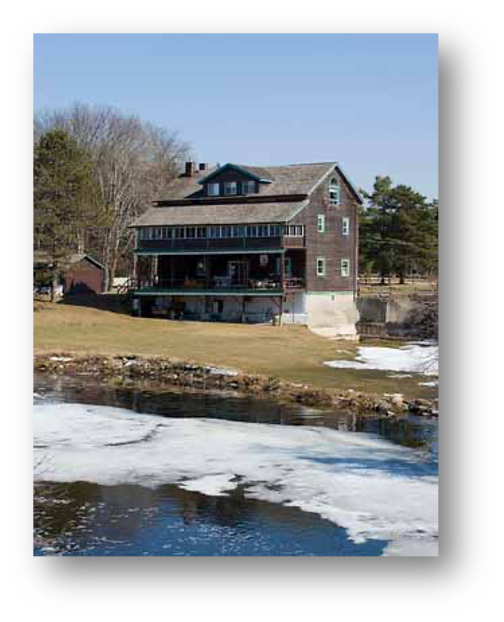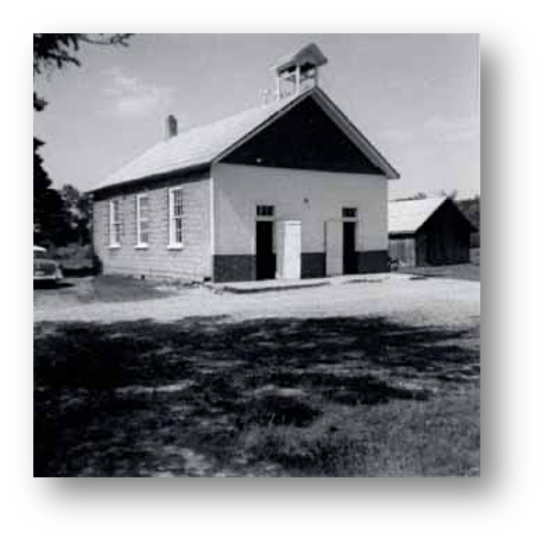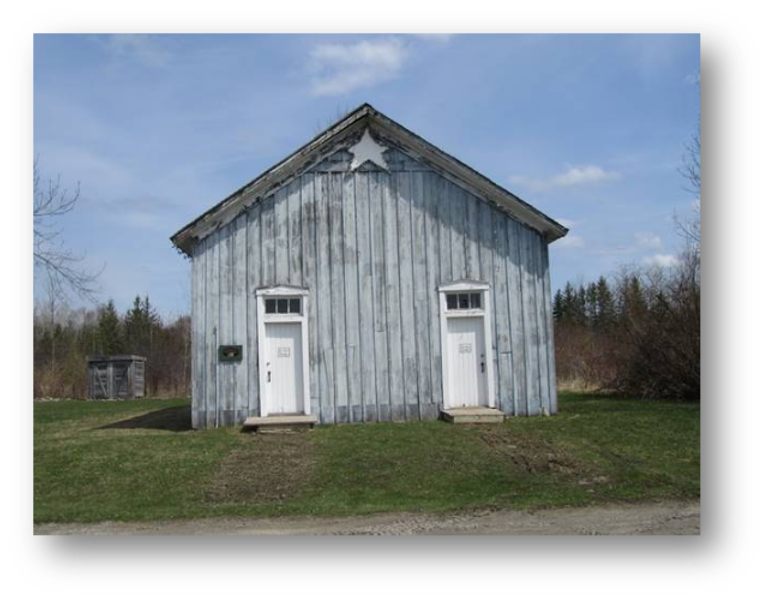Click to Download the PDF
Download the Word Doc
President’s Message
THE SHIVAREE By Tom Glover
In the late 1800s and early 1900s the Shivaree was a favourite way to celebrate a couples marriage. When the newlyweds returned from their honey moon (or on their wedding night if they did not go on a honey moon) the revellers would gather after dark at the home of the newly married couple. Waving their lanterns, shouting, banging pots and pans, they made as much noise as possible until the newlyweds rose from their bed, and after acknowledging their presence, invited them in. The bride and groom would then offer food and drink to their rowdy friends and the party would continue while the refreshments lasted, sometimes well into the night.
The event was not without incidents and I remember one tale of a gentleman who was standing on the veranda roof banging on the bedroom window of his newly married brother and his bride when he slipped and fell to the ground fracturing his ankle. The mishap did not prevent him from participating in future shivarees.
One memorable Shivaree was the result of a sarcastic comment one evening at the Ravenshoe General store. Some of the locals were hanging out in their usual fashion when a local spinster stopped in for some groceries. After she left, Stan the local livestock trucker and a man who did not hesitate to voice his opinions stated that Ruby would never marry and if she ever did, the night they shivareed her, they also could come and shivaree him and his wife. Be careful what you say for like Stan you may come to regret your words. Such a statement was not to be forgotten.
Ruby did eventually meet and marry the love of her life and was treated to one of the larger shivarees ever held in the community. The revellers then headed into Ravenshoe to the home of Stan and Gertie. Circling the house, shouting and making ever increasing noise with their pots and pans and noisemakers they awaited an appearance at the bedroom window.
Hearing the ruckus more neighbours arrived and joined in the festivities. Finally a light came on and Stan appeared at the window. He raised the window and shaking his fist and with much cursing he voiced his displeasure at their actions. The window was slammed shut and the house returned to darkness. Having received the expected reaction a cheer erupted from the crowd. The shouts and noise making continued for some time until the revellers grew tired of no more responses and calling the shivaree a success headed for their homes.
The Holborn House
10 Queensway North, Keswick
The lot at this location was originally sold to Josiah Willoughby in 1886 for $128.00. He was a carpenter and immediately set to work building this house. The Newmarket Era remarked on this property numerous times over the next two years in their local news updates from a resident correspondent as follows:
1886 – Mr. Josiah Willoughby has purchased a building lot from Elijah Prosser, Esq., and is preparing to build a brick-clad residence thereon this spring.
January 1887 – Rumor reaches us that Mr. Josiah Willoughby of this place (Keswick) is about selling his residence to Mr. Harry Winch, late of Newmarket, but if they fail to make a bargain Mr. Winch intends buying a lot and commence at once to prepare to building next summer. Our small village can already boast of having four retired farmers. Mr. Winch will make the fifth. Who will be next?
April 1887 – Mr. Josiah Willoughby having sold his residence to Mr. Henry Winch, late of Newmarket, has bought a lot from Mr. Isaac Marritt and is preparing to build as soon as spring opens.
The house belonged to the Winchs until just after the turn of the century. It changed hands a few times until the Holborns purchased it in 1940 and retained ownership until 1962. The home is remembered by many locals as “the Holborn’s”.

The house shows signs of alterations over the years, such as the second floor, which was raised at some point. It is believed that the home originally had a summer kitchen or woodshed attached to the back.
The homeowners discovered that a fire must have broken out near the fireplace downstairs leaving scorch marks behind the walls of the bedroom on the second floor above. The homeowners closed off a third doorway into the dining room to accommodate the refrigerator; something the original builder needn’t have worried about. The homeowners discovered intact linoleum from the 1920s in a second floor bedroom and preserved it.
Upon purchasing the home, the new homeowners discovered a hidden staircase that had been covered by a built-in bookcase by a previous owner. It is unknown what the purpose of this other staircase may have been. It connects to the landing of the main staircase. The community was not so wealthy to have live-in domestic nor constructed their homes with it in mind to provide servant’s staircases either. Even so, the house across the street has a similar staircase.
In the back of the property a small bark of carriage house remains. Automobiles would not be arriving into this area until long after the house was built.
Adapted from Doors Open Georgina 2013 – Editor
Georgina Trivia – Did you know that…?
William Sibbald
In 1835 William Sibbald, the son of Colonel William Sibbald and Susan (Mein) Sibbald, along with his brother Charles had been learning about farming in Upper Canada at the narrows on the northern shore of Lake Simcoe near present day Orillia. William’s mother and brother had come to visit from Scotland as they learned they were living in a tavern and were concerned for the two brothers’ well-being. After learning they were safe and doin well, they decided to take a tour of the lake. Susan apparently liked what she saw as she purchased a house on the south shore near Jackson’s Point in Georgina Township. Shortly afterwards, Susan returned to Scotland and learned her husband had died during her absence. She returned to Upper Canada to live along with her three other sons, Thomas Hugh, and Frank. William Sibbald left the narrows by steamboat with his brother Charles to live with his mother and family. This steamboat would have most likely been the Simcoe later renamed the Peter Robinson as it was the only vessel that could navigate the narrows. The only other steamboat at that time was the Colborne and her hull drew too much water. William recorded his journey from the narrows in a diary he’d just begun. The following are three of his entries:
Nov. 16/35
Left the Narrows with all our goods and chattles on board the steamboat for Georgina. There were two men and woman servant and five of ourselves and one yoke of oxen. Day stormy and blew pretty hard, lay at Barrie all night.
Nov. 17/35
The morning very rough. Arrived at Georgina about 10 Oclock A.M. landed at Jacksons Point. Had to come for our things in a scow, wind changeable with occasional showers of snow. Mr. Boucher Came. Last trip of the Steamboat this season.
Nov. 18/35
Alex Bailie went to Bouchers mills for Lumber 200f at 3/9pf. George and Arch mending fencing and clearing up about the place. Was digging a drain. Chas carpentering. Mother Mrs. Nicholl & I went to the store.
Sources:
William Sibbald diary, Archives of Ontario, Fonds F 732; available on self-serve microfilm MS 270.
https://georginagenealogy.wordpress.com/2014/05/19/diarist-william-sibbald-1116-1835-1128-1835/
GHS Occasional Paper #2 by R. W. Holden, Steamboats on the Lake Simcoe Watershed 2017
Baldwin Mills
This mill was brought from Keswick to the village of Baldwin and built piece by piece. It was completed in 1883 and operated as a gristmill. It is now a private residence.
Source: http://www.ontfin.com/Word/baldwin-mill-ontarios-old-mills/

Cooke’s Presbyterian Church

Cooke’s United Church celebrated its 100th Anniversary in 1989 and the church was closed in 2004 due to poor attendance and the congregation joined the Wilfrid Pastoral charge.
The church and the property were taken over by the Town and reopened as the Pefferlaw Youth Centre in 2005. In 2010, the Town moved the Youth Centre to the Pefferlaw Lions Community Hall and the church remained vacant until it was repurposed in 2021 as part of the new Pefferlaw firehall.
Source: Karen Wolfe
Roches Point

Where in Georgina?

Left is our newest mystery location. Unidentified last month, what and where is it? Our last mystery location showed a Metropolitan radial car rounding the curve just north of Deer Park Drive in Roches Point. Dale Taylor once again correctly identified the location after a hint in December’s issue of our newsletter.
Photo from Tom Glover
News
Village Update
The Virtual online tour of the Georgina Pioneer Village is live and can be found on the Town of Georgina website here.
10 interpretative signs will be installed in front of buildings by the end of May.
We are lucky to have Rich back this year, he is working on the Smallwood log cabin foundation and floor. He will then move on to painting the radial stations.
Construction on the school house will begin soon. Our thanks go to Jodi Pridham for this update.

Image from Tom Glover
